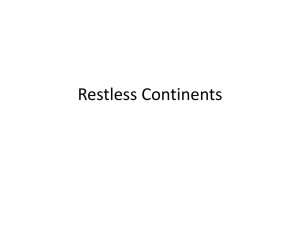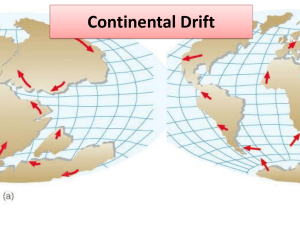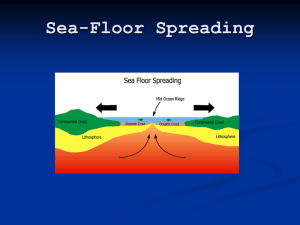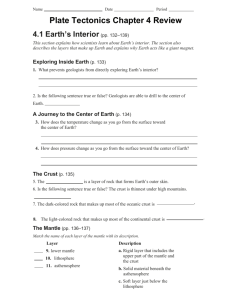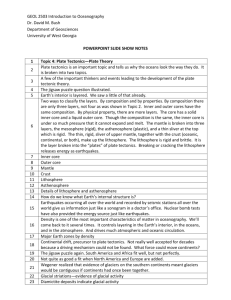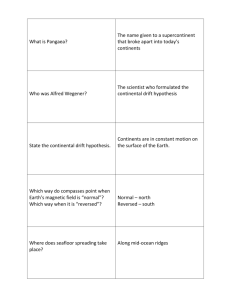restless continents text
advertisement
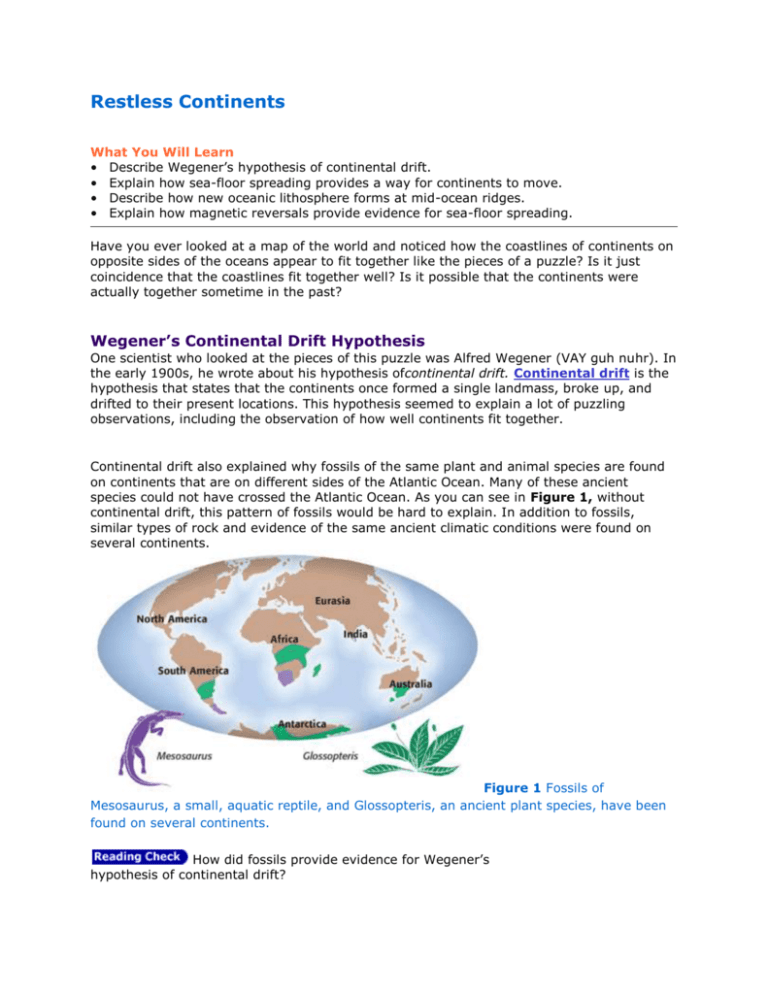
Restless Continents What You Will Learn • Describe Wegener’s hypothesis of continental drift. • Explain how sea-floor spreading provides a way for continents to move. • Describe how new oceanic lithosphere forms at mid-ocean ridges. • Explain how magnetic reversals provide evidence for sea-floor spreading. Have you ever looked at a map of the world and noticed how the coastlines of continents on opposite sides of the oceans appear to fit together like the pieces of a puzzle? Is it just coincidence that the coastlines fit together well? Is it possible that the continents were actually together sometime in the past? Wegener’s Continental Drift Hypothesis One scientist who looked at the pieces of this puzzle was Alfred Wegener (VAY guh nuhr). In the early 1900s, he wrote about his hypothesis ofcontinental drift. Continental drift is the hypothesis that states that the continents once formed a single landmass, broke up, and drifted to their present locations. This hypothesis seemed to explain a lot of puzzling observations, including the observation of how well continents fit together. Continental drift also explained why fossils of the same plant and animal species are found on continents that are on different sides of the Atlantic Ocean. Many of these ancient species could not have crossed the Atlantic Ocean. As you can see in Figure 1, without continental drift, this pattern of fossils would be hard to explain. In addition to fossils, similar types of rock and evidence of the same ancient climatic conditions were found on several continents. Figure 1 Fossils of Mesosaurus, a small, aquatic reptile, and Glossopteris, an ancient plant species, have been found on several continents. How did fossils provide evidence for Wegener’s hypothesis of continental drift? The Breakup of Pangaea Wegener made many observations before proposing his hypothesis of continental drift. He thought that all of the present continents were once joined in a single, huge continent. Wegener called this continent Pangaea(pan JEE uh), which is Greek for “all earth.” We now know from the hypothesis of plate tectonics that Pangaea existed about 245 million years ago. We also know that Pangaea further split into two huge continents—Laurasia and Gondwana—about 180 million years ago. As shown in Figure 2, these two continents split again and formed the continents we know today. Figure 2 The Drifting Continents Sea-Floor Spreading When Wegener put forth his hypothesis of continental drift, many scientists would not accept his hypothesis. From the calculated strength of the rocks, it did not seem possible for the crust to move in this way. During Wegener’s life, no one knew the answer. It wasn’t until many years later that evidence provided some clues to the forces that moved the continents. Mid-Ocean Ridges and Sea-Floor Spreading A chain of submerged mountains runs through the center of the Atlantic Ocean. The chain is part of a worldwide system of mid-ocean ridges. Mid-ocean ridges are underwater mountain chains that run through Earth’s ocean basins. Mid-ocean ridges are places where sea-floor spreading takes place. Sea-floor spreading is the process by which new oceanic lithosphere forms as magma rises toward the surface and solidifies. As the tectonic plates move away from each other, the sea floor spreads apart and magma fills in the gap. As this new crust forms, the older crust gets pushed away from the mid-ocean ridge. As Figure 3 shows, the older crust is farther away from the mid-ocean ridge than the younger crust is. Figure 3 Sea-Floor Spreading Sea-floor spreading creates new oceanic lithosphere at midocean ridges. Evidence for Sea-Floor Spreading: Magnetic Reversals Some of the most important evidence of sea-floor spreading comes from magnetic reversals recorded in the ocean floor. Throughout Earth’s history, the north and south magnetic poles have changed places many times. When the poles change places, the polarity of Earth’s magnetic poles changes, as shown in Figure 4. When Earth’s magnetic poles change places, this change is called a magnetic reversal. Figure 4 The polarity of Earth’s magnetic field changes over time Magnetic Reversals and Sea-Floor Spreading The molten rock at the mid-ocean ridges contains tiny grains of magnetic minerals. These mineral grains contain iron and are like compasses. They align with the magnetic field of the Earth. When the molten rock cools, the record of these tiny compasses remains in the rock. This record is then carried slowly away from the spreading center of the ridge as sea-floor spreading occurs. As you can see in Figure 5, when the Earth’s magnetic field reverses, the magnetic mineral grains align in the opposite direction. The new rock records the direction of the Earth’s magnetic field. As the sea floor spreads away from a mid-ocean ridge, it carries with it a record of magnetic reversals. This record of magnetic reversals was the final proof that seafloor spreading does occur. Figure 5 Magnetic reversals in oceanic crust are shown as bands of light blue and dark blue oceanic crust. Light blue bands indicate normal polarity, and dark blue bands indicate reverse polarity. How is a record of magnetic reversals recorded in molten rock at mid-ocean ridges? Section Summary • Wegener hypothesized that continents drift apart from one another and have done so in the past. • The process by which new oceanic lithosphere forms at mid-ocean ridges is called seafloor spreading. • As tectonic plates separate, the sea floor spreads apart and magma fills in the gap. • Magnetic reversals are recorded over time in oceanic crust.
